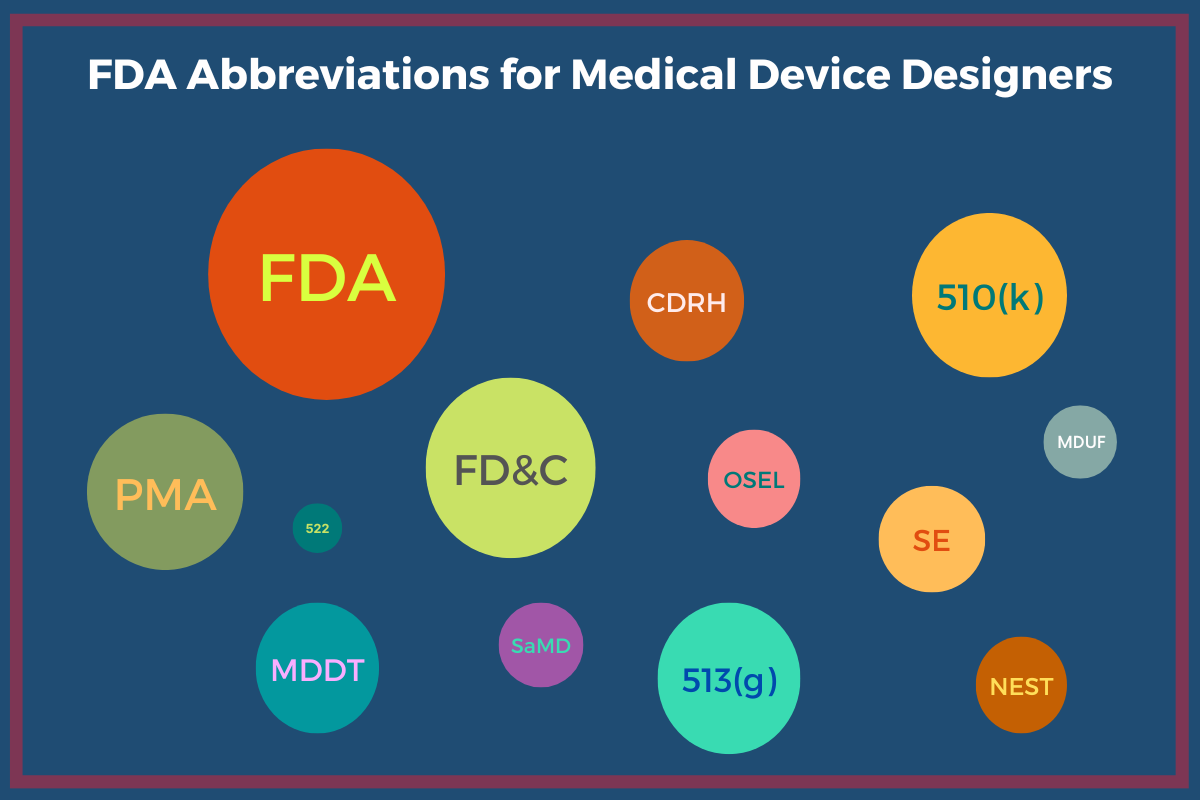If you want to market medical devices in the United States, you must go through a process with the FDA. To help you get started, here’s a few of the most commonly used FDA abbreviations.
What parts of the FDA might I need to deal with?
There are a wide range of medical devices, from a simple toothbrush to a complex surgical robot using medical software. Therefore, there are a variety of regulatory pathways your device might take to get FDA approval. These are the most likely:
FDA – The Food and Drug Administration is a federal agency within the U.S. Department of Health and Human Services. Among other things, the FDA regulates food, drugs, and medical devices (hardware and software) that are marketed in the USA.
CDRH – The Center for Devices and Radiological Health. As a branch of the FDA, the Center is responsible for making sure that medical devices marketed in the U.S. are “safe effective, and high-quality.” It provides the medical device industry with “predictable, consistent, transparent, and efficient regulatory pathways.” The CDRH is responsible for dividing medical devices into Class I, Class II, and Class III devices based on risk factors. After the medical devices are released to market, the CDRH is responsible for overseeing the manufacturing, effectiveness, and safety of the devices.
OSEL – The Office of Science and Engineering Laboratories. As part of CDRH, the OSEL conducts regulatory research for medical devices.
What are some common FDA abbreviations for medical devices?
510(k) – The 510(k) Premarket Notification is named for a section of the FD&C Act. A 510(k) submission is used to determine if a product is “substantially equivalent” to existing devices. This usually covers Class II devices, which warrant review but not the full approval process with extensive clinical trials that Class III devices go through.
513(g) – The 513(g) Request for Information. Section 513(g) of the FD&C Act provides a way that device manufacturers can apply for a formal response to classification and regulations for a particular device.
522 – The FDA Postmarket Surveillance Studies Program. Named after a section of the FD&C Act, Section 522 gives the FDA the authority to require manufactures to do postmarket surveillance at approval/clearance, or afterwards for some Class II and III devices.
FD&C Act – The Federal Food, Drug, and Cosmetic Act. The FD&C Act is one of the U.S. federal laws that establishes the legal framework in which the FDA operates. Further amendments and updates occur from the Food and Drug Administration Amendments of 2007 (FDAAA), the Food and Drug Administration Modernization Act (FDAMA), and the Food and Drug Administration Safety and Innovation Act of 2012 (FDASIA).
MDDT – Medical Device Development Tool. The MDDT program is intended to help the medical device development and evaluation process with tools for making it “more efficient and predictable” to collect the information needed to move submissions to clearance.
MDUF – Medical Device User Fee. User fees for medical device premarket applications were established and then amended several times via the Medical Device User Fee and Modernization Act (MDUFMA) and the Medical Device User Fee Amendments (MDUFA).
NEST – The National Evaluation System for health Technology. NEST is a system run by the non-profit Medical Device Innovation Consortium (MDIC) using the NEST Coordinating Center (NESTcc). The FDA provided funding for the NEST project to help with device surveillance and evaluation, as a complement to its own efforts.
PMA – Premarket Approval. (See 510(k).)
SaMD – Software as a Medical Device. Software that is intended for medical purposes without being part of a hardware medical device is itself considered as a medical device.
SE – Substantially Equivalent. A device manufactures might claim SE when filing a 510(k) Premarket Submission that their device is substantially equivalent to another similar device legally marketed in the U.S. The device does not have to be identical to the one it is being compared to. It must, however, have the same intended use and has the same “technological characteristics” or ones that don’t raise “different questions of safety and effectiveness,” as determined by the FDA.
The FDA is committed to assuring that the medical devices available for the US market are safe and effective. Just as medical devices can vary widely, the specific regulations, guidances, and processes required to prove that a device should be cleared for market will vary. It is always a good idea to consult regulatory experts as you develop your medical device.
Now that you know a few of the common terms used in the process, here is some more information from the FDA:
________________________
RAM Technologies has been supplying PC power supplies for FDA-approved medical devices since 1996. Contact us for details.
